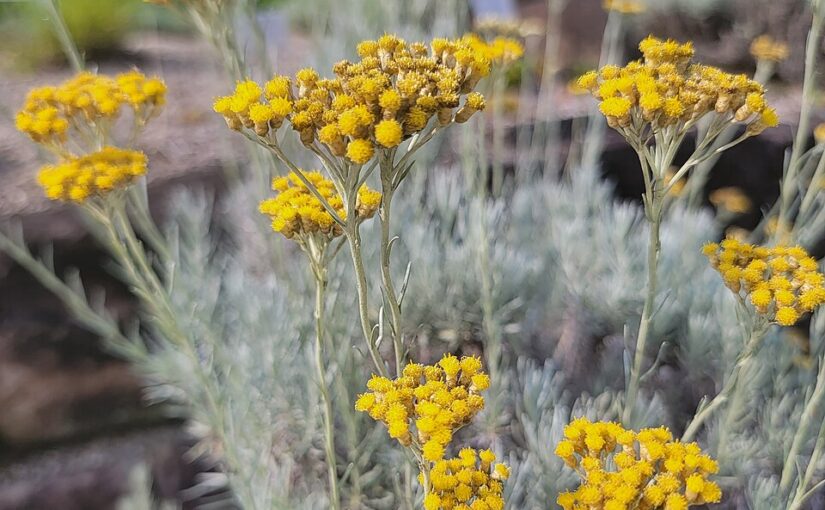Helichrysum essential oil, often called immortelle or everlasting, comes from the Helichrysum italicum plant, a member of the Asteraceae family. Native to the sun-drenched regions of the eastern Mediterranean, including Crete and North Africa, as well as parts of Asia, this resilient herb has spread to cultivation in places like Italy, France, particularly Corsica, Slovenia, the former Yugoslavia, Spain, Madagascar, Australasia, South Africa, and the United States. The oil is steam-distilled from the fresh flowers and flowering tops, with major production in France and Slovenia yielding a pale yellow to red oily liquid or, in absolute form, a yellow to brown viscous substance.
The aroma is rich and inviting, blending sweet honey notes with herbal, fruity, floral, and tea-like undertones, positioning it as a middle note in blends. Its chemical makeup includes alpha-pinene at 21 to 30 percent, along with neryl acetate, gamma-curcumene, italidiones, beta-caryophyllene, beta-selinene, italicene, and limonene. These compounds drive the oil’s renowned regenerative and calming properties, making it a staple in natural healing practices.
Historical and Cultural Significance
Helichrysum has long been cherished for its enduring qualities, earning the name immortelle from its vibrant flowers that retain their color and scent long after picking. In medieval times, the golden blooms served as strewing herbs on floors, releasing a honeyed fragrance to freshen spaces and ward off ills. Thriving in harsh environments like Corsican beaches and Balkan mountains, the plant symbolizes resilience in both Ayurvedic traditions and European herbalism.
Known as the Oil for Pain, helichrysum has been used for centuries to heal physical wounds and lift the spirit. Its Mediterranean roots tie it to ancient rituals of renewal, where the herb’s sunny disposition provided comfort and strength. Today, it continues this legacy, bridging historical wisdom with modern wellness as a balm for body and soul.
Therapeutic Benefits
Helichrysum essential oil stands out for its restorative effects, particularly on the skin and inflammation. As a cicatrizant and vulnerary, it promotes healing of wounds, cuts, burns including sunburns, bruises, scars, stretch marks, and broken capillaries by stimulating new cell growth. Its anti-inflammatory and analgesic actions soothe acne, eczema, dermatitis, arthritis, muscle aches, and sprains, offering targeted relief.
The oil’s antiallergic and antifungal properties help ease allergies, asthma, and infections like candida, while its antimicrobial and antiviral qualities combat bacterial and viral threats, such as herpes. For respiratory support, it acts as an expectorant and antitussive, clearing bronchitis, sinusitis, chronic coughs, colds, and flu. Additionally, its diuretic and cholagogue effects reduce fluid retention and aid liver detoxification.
On an emotional level, helichrysum serves as a nervine and antidepressant, alleviating stress, depression, nervous exhaustion, and burnout. Its insecticidal nature repels pests and calms bites or stings. Key components like neryl acetate and italidiones enhance its skin-regenerating, anti-inflammatory, and soothing capabilities, establishing it as a go-to in advanced skincare and holistic therapy.
Aromatherapy Applications
Incorporating helichrysum essential oil into daily routines is straightforward and effective, though its high cost calls for mindful use. For topical application, dilute three to six drops in one ounce of carrier oil like jojoba and massage into scars, bruises, burns, or painful joints. This blend also works well for acne, eczema, or insect bites, providing quick relief.
In skincare, add one or two drops to moisturizers to support anti-aging and regeneration, helping maintain a youthful glow. For inhalation, place two drops on a tissue and breathe deeply to ease asthma, sinusitis, or stress. Baths benefit from four to six drops mixed with a dispersant in warm water, promoting muscle relaxation and emotional calm. Diffusion suits sparse use, with two to three drops in 100 milliliters of water, often blended with lavender for meditation.
Reserve helichrysum for topical applications and dilute to one or two percent—six to twelve drops per ounce of carrier—for safety. Avoid it on puncture wounds, as its rapid healing might seal in infections.
Emotional and Energetic Effects
Helichrysum’s warm, honey-like scent extends beyond physical healing to mend emotional wounds, earning its title as the Oil for Pain. It gently releases trauma, despair, and anguish, restoring hope and guiding those feeling like the walking wounded toward spiritual rebirth with renewed courage and gratitude. Associated with the solar plexus, sacral, and base chakras, its yin energy and earth element provide grounding upliftment, making it ideal for meditation and releasing past pain.
This oil addresses emotions like trauma, despair, emotional pain, burnout, hopelessness, and stress, fostering resilience and a positive outlook. In energetic practices, it supports letting go, inviting serenity and renewal into daily life.
Blending and Safety Considerations
Helichrysum blends seamlessly with cedarwood, chamomile, citrus oils, clary sage, clove, frankincense, geranium, juniper, lavender, Peru balsam, rose, bergamot, mandarin, Roman chamomile, and rosewood. Companion oils such as ginger, hyssop, wintergreen, frankincense, and rose amplify its healing. For substitutes in wound care or emotional support, consider cypress, frankincense, or myrrh.
Safety is straightforward: helichrysum is nontoxic, nonirritant, and nonsensitizing, but always patch test for sensitivity. Store in a dark glass bottle in a cool, dark place for a shelf life of four to six years if unoxidized. Due to its expense, source authentic oil to avoid adulteration, and use externally only unless guided by a professional. Avoid ingestion and application to open puncture wounds.
Helichrysum’s Golden Radiance
Helichrysum essential oil captures the essence of golden flowers on a Corsican hillside, its sweet herbal scent mending scars and soothing the soul. From fading physical marks to healing emotional depths, this everlasting remedy embodies Mediterranean resilience. Whether in skincare or meditation, helichrysum invites release and renewal, rooted in timeless wisdom for holistic well-being.
Image by Fritzmann2002.
Ready to deepen your journey into the world of aromatherapy? Subscribe to the Scent & Breath biweekly newsletter. Every two weeks, you will receive a fresh blend of ancient wisdom and modern science, including exclusive recipes, practical safety guides, and inspiring stories to help you transform your daily rituals into moments of mindfulness. Join our community and let every breath be a step toward well-being.
